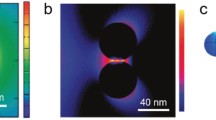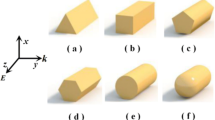Abstract
The plasmon resonance of metal nanoparticles shifts upon refractive index changes of the surrounding medium through the binding of analytes. The use of this principle allows one to build ultra-small plasmon sensors that can detect analytes (e.g., biomolecules) in volumes down to attoliters. We use simulations based on the boundary element method to determine the sensitivity of gold nanorods of various aspect ratios for plasmonic sensors and find values between 3 and 4 to be optimal. Experiments on single particles confirm these theoretical results. We are able to explain the optimum by showing a corresponding maximum for the quality factor of the plasmon resonance.




Similar content being viewed by others
References
Jain PK, Huang WY, El-Sayed MA (2007) On the universal scaling behavior of the distance decay of plasmon coupling in metal nanoparticle pairs: a plasmon ruler equation. Nano Lett 7(7):2080–2088
Sönnichsen C, Reinhard BM, Liphardt J, Alivisatos AP (2005) A molecular ruler based on plasmon coupling of single gold and silver nanoparticles. Nat Biotechnol 23(6):741–745
Wang HY, Reinhard BM (2009) Monitoring simultaneous distance and orientation changes in discrete dimers of DNA-linked gold nanoparticles. J Phys Chem C 113(26):11215–11222
Reinhard BM, Siu M, Agarwal H, Alivisatos AP, Liphardt J (2005) Calibration of dynamic molecular rule based on plasmon coupling between gold nanoparticles. Nano Lett 5(11):2246–2252
Sönnichsen C, Alivisatos AP (2005) Gold nanorods as novel nonbleaching plasmon-based orientation sensors for polarized single-particle microscopy. Nano Lett 5(2):301–304
Bingham JM, Willets KA, Shah NC, Andrews DQ, Van Duyne RP (2009) Localized surface plasmon resonance imaging: simultaneous single nanoparticle spectroscopy and diffusional dynamics. J Phys Chem C 113(39):16839–16842
Pierrat S, Hartinger E, Faiss S, Janshoff A, Sonnichsen C (2009) Rotational dynamics of laterally frozen nanoparticles specifically attached to biomembranes. J Phys Chem C 113(26):11179–11183
Schubert O, Becker J, Carbone L, Khalavka Y, Provalska T, Zins I, Sönnichsen C (2008) Mapping the polarization pattern of plasmon modes reveals nanoparticle symmetry. Nano Lett 8(8):2345–2350
Novo C, Funston AM, Mulvaney P (2008) Direct observation of chemical reactions on single gold nanocrystals using surface plasmon spectroscopy. Nat Nanotechnol 3(10):598–602
Carbone L, Jakab A, Khalavka Y, Sönnichsen C (2009) Light-controlled one-sided growth of large plasmonic gold domains on quantum rods observed on the single particle level. Nano Lett 9(11):3710–3714
Perez-Juste J, Pastoriza-Santos I, Liz-Marzan LM, Mulvaney P (2005) Gold nanorods: synthesis, characterization and applications. Coord Chem Rev 249(17–18):1870–1901
Homola J, Yee SS, Gauglitz G (1999) Surface plasmon resonance sensors: review. Sens Actuators B Chem 54(1–2):3–15
Sönnichsen C, Geier S, Hecker NE, von Plessen G, Feldmann J, Ditlbacher H, Lamprecht B, Krenn JR, Aussenegg FR, Chan VZH, Spatz JP, Moller M (2000) Spectroscopy of single metallic nanoparticles using total internal reflection microscopy. Appl Phys Lett 77(19):2949–2951
Raschke G, Kowarik S, Franzl T, Sönnichsen C, Klar TA, Feldmann J, Nichtl A, Kurzinger K (2003) Biomolecular recognition based on single gold nanoparticle light scattering. Nano Lett 3(7):935–938
Sönnichsen C, Franzl T, Wilk T, von Plessen G, Feldmann J, Wilson O, Mulvaney P (2002) Drastic reduction of plasmon damping in gold nanorods. Phys. Rev. Lett. 88(7):077402
Becker J, Schubert O, Sönnichsen C (2007) Gold nanoparticle growth monitored in situ using a novel fast optical single-particle spectroscopy method. Nano Lett 7(6):1664–1669
McFarland AD, Van Duyne RP (2003) Single silver nanoparticles as real-time optical sensors with zeptomole sensitivity. Nano Lett 3(8):1057–1062
Baciu CL, Becker J, Janshoff A, Sönnichsen C (2008) Protein-membrane interaction probed by single plasmonic nanoparticles. Nano Lett 8(6):1724–1728
Lee KS, El-Sayed MA (2006) Gold and silver nanoparticles in sensing and imaging: sensitivity of plasmon response to size, shape, and metal composition. J Phys Chem 110(39):19220–19225
Khalavka Y, Becker J, Sönnichsen C (2009) Synthesis of rod-shaped gold nanorattles with improved plasmon sensitivity and catalytic activity. J Am Chem Soc 131(5):1871–1875
Liu N, Weiss T, Mesch M, Langguth L, Eigenthaler U, Hirscher M, Sönnichsen C, Giessen H (2009) Planar Metamaterial Analogue of Electromagnetically Induced Transparency for Plasmonic Sensing. Nano Lett. doi:10.1021/nl902621d
Becker J, Zins I, Jakab A, Khalavka Y, Schubert O, Sönnichsen C (2008) Plasmonic focusing reduces ensemble linewidth of silver-coated gold nanorods. Nano Lett 8(6):1719–1723
Hohenester U, Krenn J (2005) Surface plasmon resonances of single and coupled metallic nanoparticles: A boundary integral method approach. Phys. Rev. B 72(19):195429
de Abajo FJG, Howie A (2002) Retarded field calculation of electron energy loss in inhomogeneous dielectrics. Phys. Rev. B 65(11):115418
Burgin J, Liu MZ, Guyot-Sionnest P (2008) Dielectric sensing with deposited gold bipyramids. J Phys Chem 112(49):19279–19282
Sherry LJ, Chang SH, Schatz GC, Van Duyne RP, Wiley BJ, Xia YN (2005) Localized surface plasmon resonance spectroscopy of single silver nanocubes. Nano Lett 5(10):2034–2038
Johnson PB, Christy RW (1972) Optical Constants of the Noble Metals. Phys Rev B 6(12):4370-4379
Prescott SW, Mulvaney P (2006) Gold nanorod extinction spectra. c 99(12):123504
Bryant GW, De Abajo FJG, Aizpurua J (2008) Mapping the plasmon resonances of metallic nanoantennas. Nano Lett 8(2):631–636
Liu MZ, Guyot-Sionnest P (2004) Synthesis and optical characterization of Au/Ag core/shell nanorods. J Phys Chem B 108(19):5882–5888
Bohren CF, Huffman DR (1983) Absorption and Scattering of Light by Small Particles. Wiley
Osborn JA (1945) Demagnetizing factors of the general ellipsoid. Phys Rev 67(11–1):351–357
Sönnichsen C (2001) Plasmons in metal nanostructures. Cuvillier Verlag Göttingen
Lambrecht A, Pirozhenko I, Duraffourg L, Andreucci P (2007) The Casimir effect for silicon and gold slabs. Epl 77(4):44006
Cao M, Wang M, Gu N (2009) Optimized surface plasmon resonance sensitivity of gold nanoboxes for sensing applications. J Phys Chem C 113(4):1217–1221
Nikoobakht B, El-Sayed MA (2003) Preparation and growth mechanism of gold nanorods (NRs) using seed-mediated growth method. Chem Mater 15(10):1957–1962
Acknowledgment
We acknowledge financial support by the DFG through the Emmy Noether Program (SO712/1-3), the MAINZ graduate school of excellence, and the Graz Advanced School of Science (NAWI GASS).
Author information
Authors and Affiliations
Corresponding author
Appendix
Appendix
Methods
Simulations based on boundary element method
In our computational approach, we discretize the surface of the nanoparticle by a set of triangles and match the electromagnetic potentials at the triangle centers. By fulfilling the boundary conditions imposed by Maxwell’s equations through auxiliary surface charges and currents, we end up with a generic and flexible scheme that allows us to compute the optical properties of arbitrarily shaped nanoparticles with complex geometry embedded in dielectric environments.
The dielectric function of the gold nanorods was extracted from optical data [27] and the chosen mesh sizes allow for a spatial resolution of approximately 1 nm.
Determination of S, FOM, FOM*, and FOM*layer
We calculated the light scattering cross-section C sca for every particle shape (diameter 20 nm, length from 20 nm to 160 nm in steps of 2 nm) in n 1 = 1.33 and in n 2 = 1.34 as a function of wavelengths λ (in steps of 1 nm).
The FOM* was calculated according to the following equation:
The FOM*layer was calculated in the same way in the quasi-static approximation for spheroids for layer thicknesses l = 0.01 nm to 10 nm in steps of 1 nm (0.01 nm until the first nanometer).
Gold nanorods preparation
Gold nanorods were synthesized according to the seeded growth procedure published by Nikoobakht et al. [36]. In this two-step synthesis, preformed seeds grow into rods in a concentrated surfactant solution. The samples used in this work were characterized by ensemble extinction spectroscopy and transmission electron microscopy to obtain the mean diameters and lengths of the different samples. The samples we used had the following properties:
Name | λ res | Width | Length |
LC 12-1 | 634 | 57 ± 6 | 28 ± 4 |
S702 | 700 | 49 ± 4 | 18 ± 2 |
S740 | 743 | 55 ± 6 | 18 ± 3 |
Single particle spectroscopy
To investigate the spectral shift by changes in the refractive index of the environment on the single particle level, we dilute the nanorod suspensions 1:100 with distilled water and rinse them for 5 min through a flat glass capillary connected to PET tubing. Subsequent rinsing of 1 M sodium chloride solution for 1 min can increase the number of immobilized particles. Afterwards, the glass capillary is rinsed for at least 15 min with distilled water (n = 1.333) to remove as many of the molecules as possible that were attached to the particle surface, and the scattering spectra of all particles in the field of view recorded. After rinsing the glass capillary with glucose solution (25 wt.% n = 1.372) for 15 min, we again investigate the scattering spectra of the same particles and determine the quantities listed in Table 1.
Rights and permissions
About this article
Cite this article
Becker, J., Trügler, A., Jakab, A. et al. The Optimal Aspect Ratio of Gold Nanorods for Plasmonic Bio-sensing. Plasmonics 5, 161–167 (2010). https://doi.org/10.1007/s11468-010-9130-2
Received:
Accepted:
Published:
Issue Date:
DOI: https://doi.org/10.1007/s11468-010-9130-2




